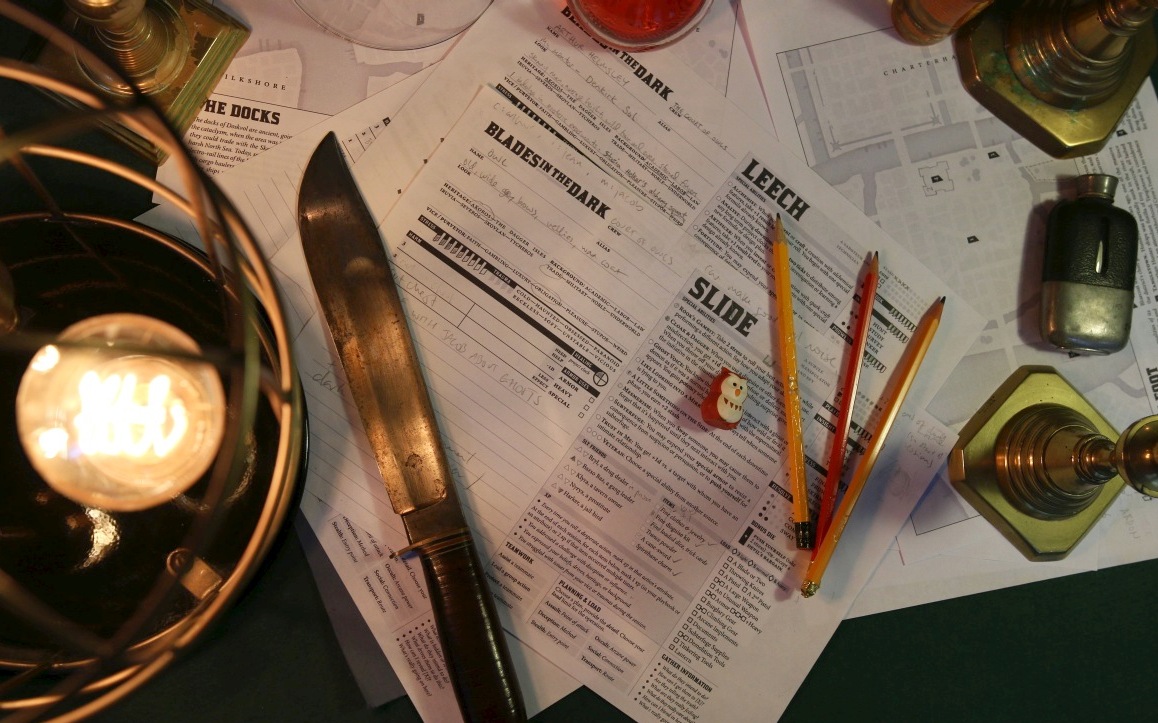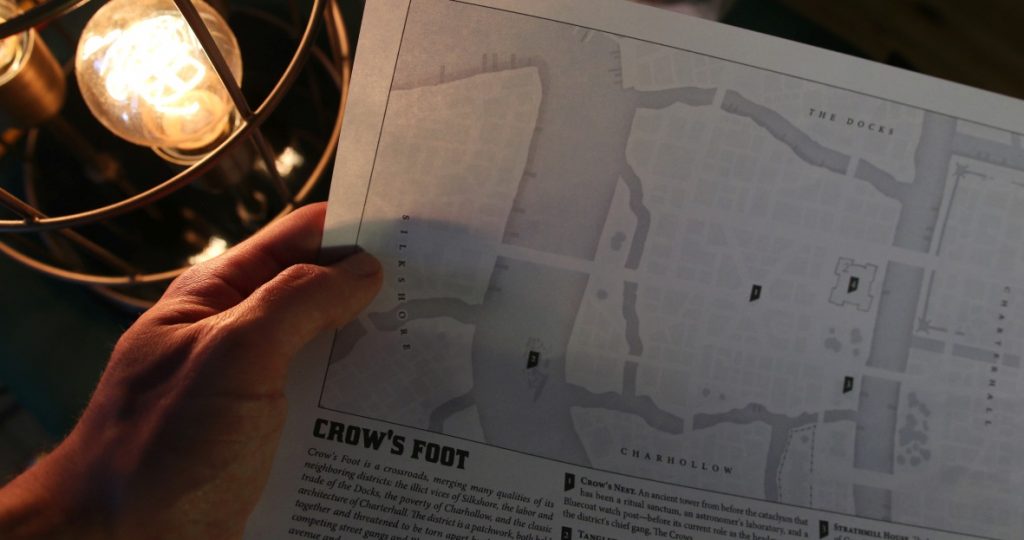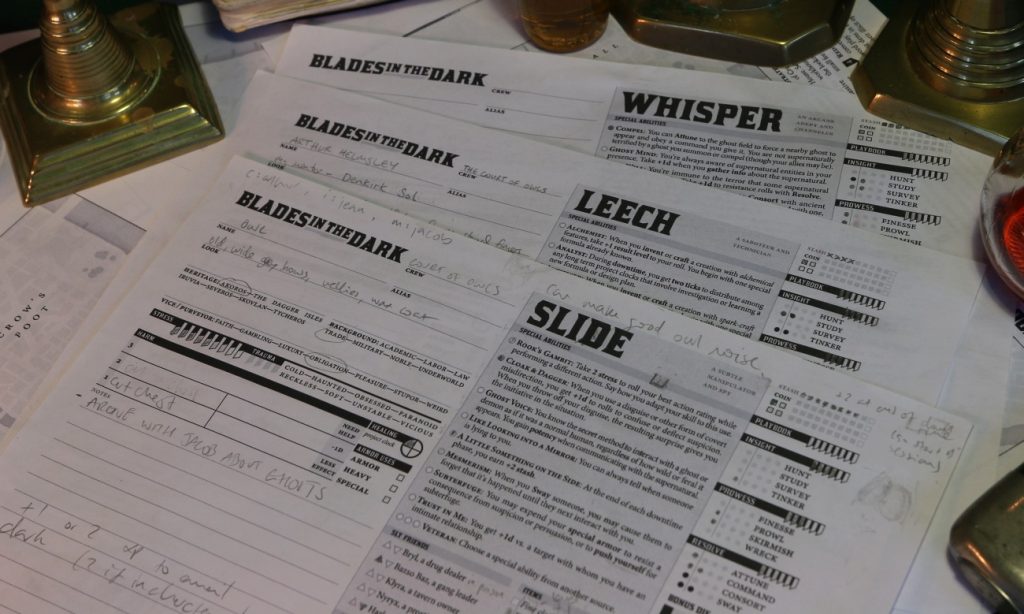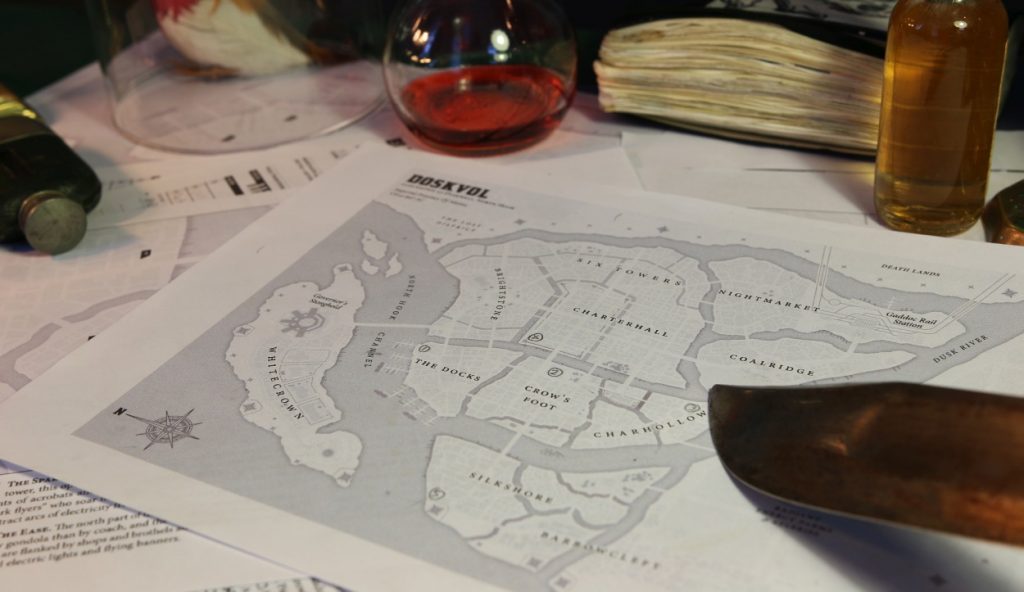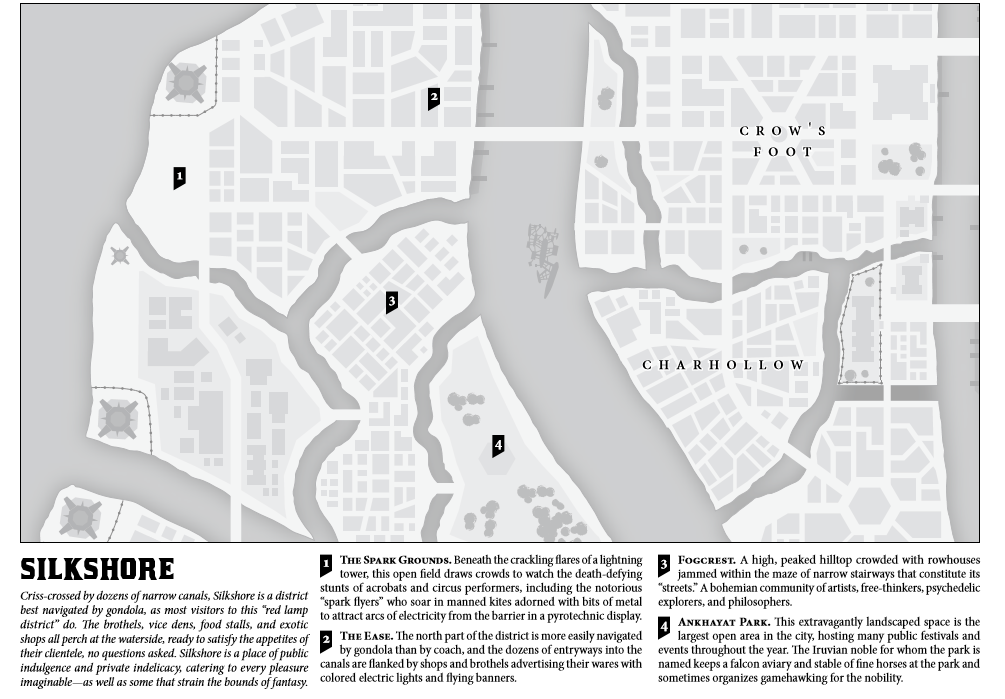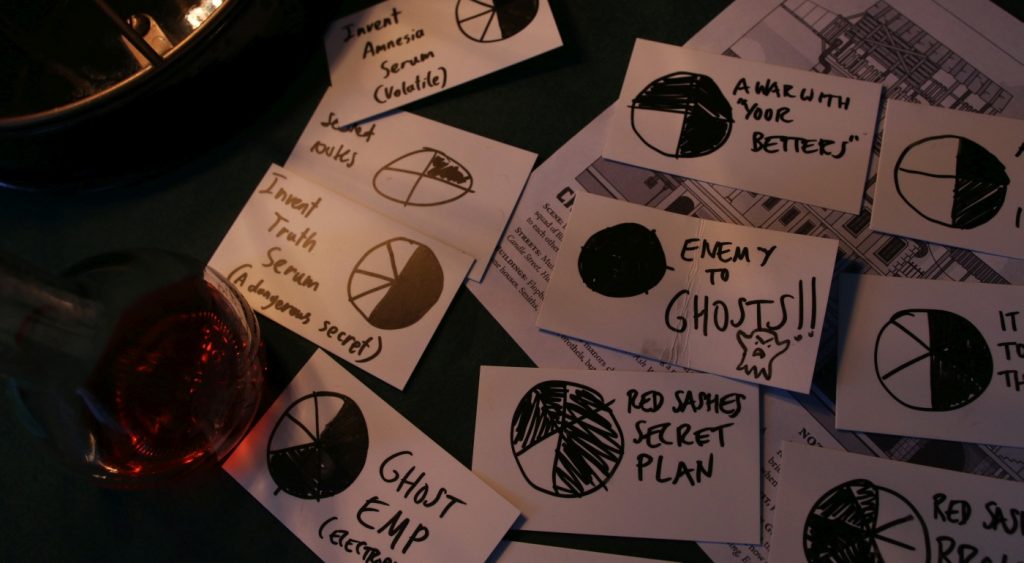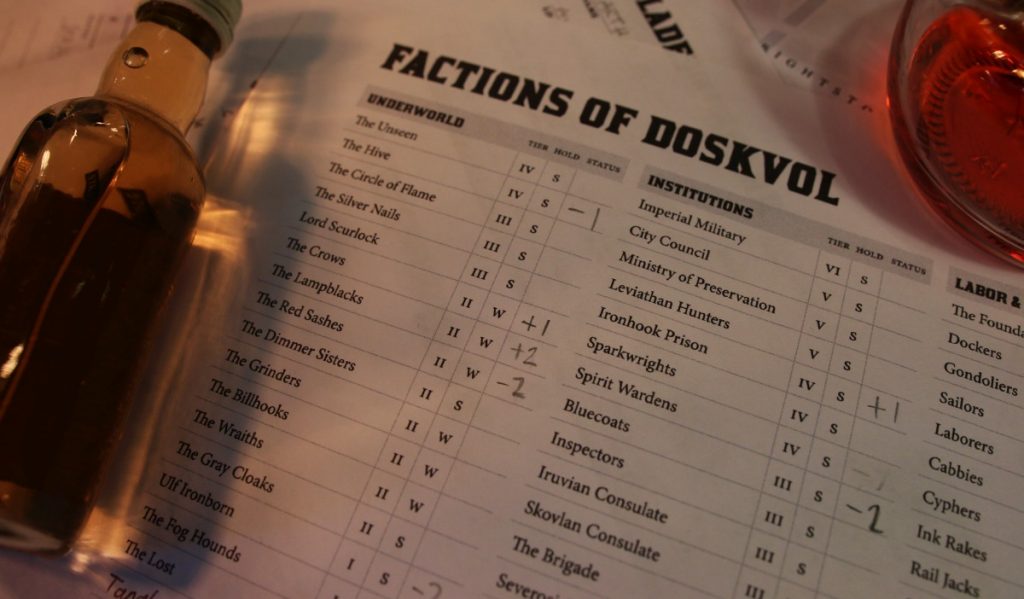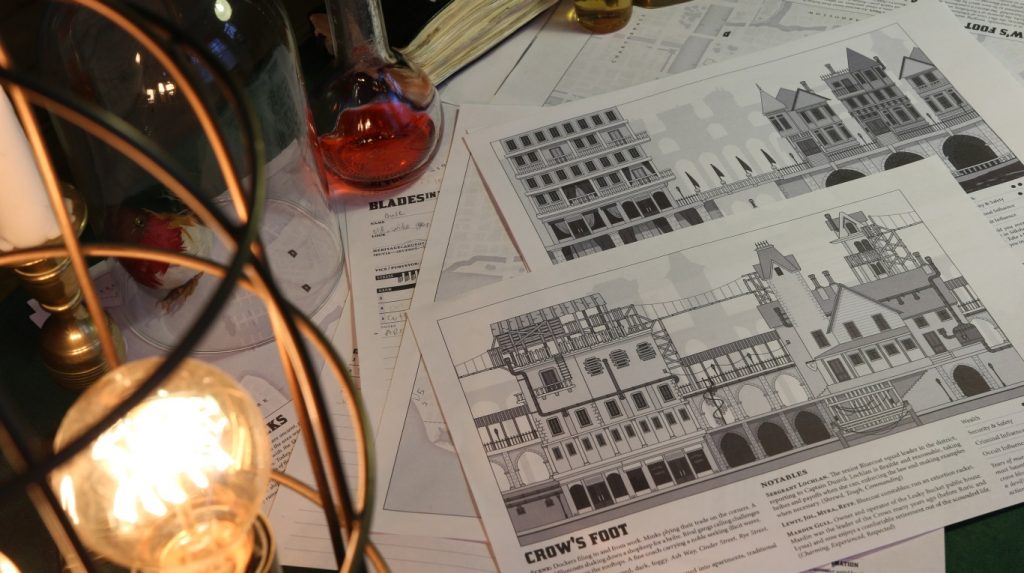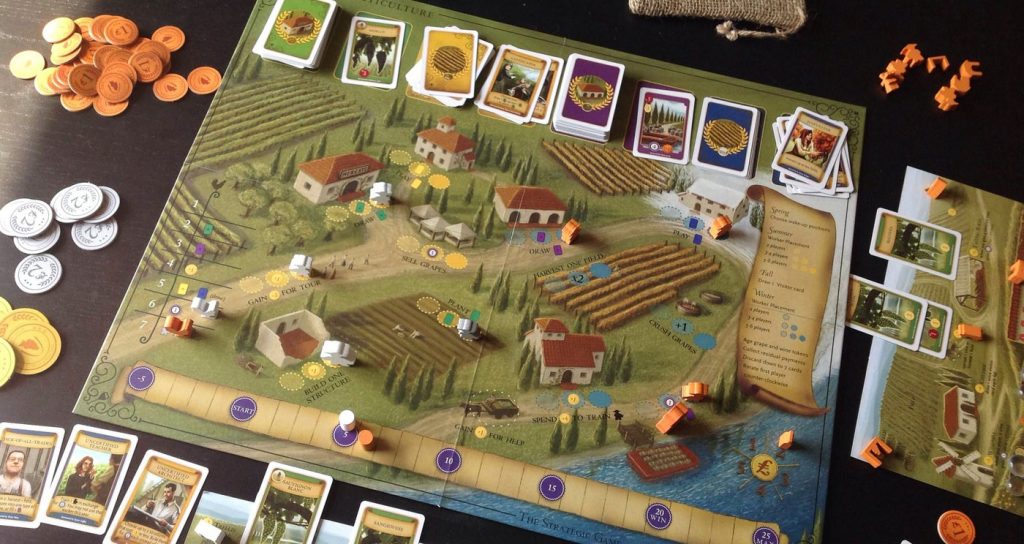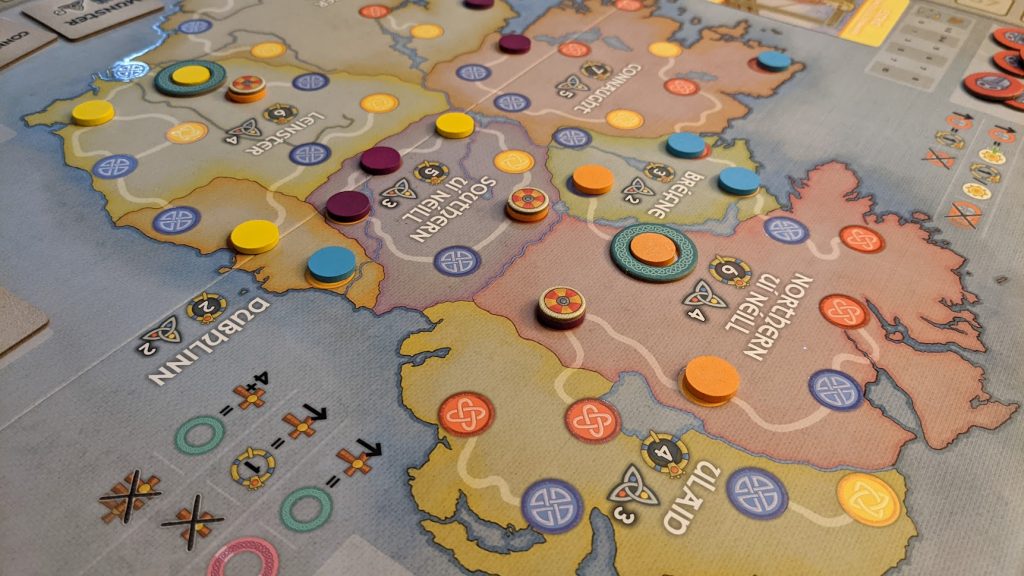Quinns: Remember last month when we reviewed Tales from the Loop, the charming sci-fi RPG of bicycles, bottle rockets and 1980s theme songs? Today we’re going to look at the other new role-playing game that’s been turning heads among my friends, and we’re going as villainous as Tales from the Loop was innocent.
Blades in the Dark is a game by John Harper, who you might remember from Cynthia’s review of superb free RPG Lady Blackbird. But while that game was an improbable 15 pages, Blades is 336 pages. By comparison, it’s his opus.
Which is very good news if (like me) you’re a fan of Scott Lynch’s Locke Lamora books or the heist genre in general, because Blades is a game of playing regency-era criminals. Oh, yes. This is a scoundrel simulator, and whether you want to play a crew of classy vice dealers, some down-and-dirty brawlers, or even a worrisome cult is simply the first of one million entertaining decisions that you’ll be making.
Blades in the Dark also offers a vast, seductive backdrop to your escapades: The haunted city of Doskvol, which will be familiar to anyone who’s ever escaped into gloompunk videogames like Thief, Dishonored, Sunless Sea or Fallen London.
This is going to be a long review, and not just because this is a huge book. You see, not only is Blades the most fun that my friends and I have ever had playing an RPG, it’s also like nothing I’ve ever played.
It’s probably simplest to start with the rules for the cool crimes themselves, called “Scores”. After all, your campaign of Blades will probably begin with an action-packed score, in the same way that a game of D&D usually begins with a lot of goblins charging out of the woods at your caravan.
In any other RPG performing a heist would involve an hour-long discussion of plans and contingencies amongst the players, only for said plan to evaporate within 5 minutes of you entering the building.
Not so in Blades. In what will initially feel to your players like jumping out of a plane, when a Score begins the players simply name the style of their approach (Deception, Stealth or Assault are the common ones) and our movie “cuts” to the crew arriving at the building, ready to put their plan into action. All of the actual planning happens “off-camera”.
What happens next is virtuosic. I’m aware that we throw around hyperbaton like it’s confetti in these RPG reviews, but stick with me for just a second.
While players do hardly any actual planning, they are instead allowed to narrate flashbacks. Imagine a Georgian George Clooney walking everybody through an Oceans 11-style heist, revealing bits of the plan as obstacles come up. So when a guard sees a player, a player can say “That’s ok. We threatened his family last week.” The game then jumps back in time, and you spend a minute roleplaying the scene where the players threaten the guard’s family, rolling dice to see if your threat was successful, before jumping back to present.
There is absolutely no limit to how extravagant these flashbacks can be, only a cost in “Stress points” decided by the GM. If a player ever reaches 10 stress, they abandon the heist. If this happens four times, your character loses their taste for this nonsense and must be retired. This system is all at once freeing, simple and incredible fun.
In my first ever session of Blades my players were stealing guns from the upper apartments of a tall building, only to realise that they had no way to transport the loot out of here. So someone quickly narrated a flashback where they paid some local urchins to wait for this very moment on the next roof over, allowing the crew to throw them a rope and send the guns along it in a sack.
But were the players carrying a long rope and a sack at that moment? Of course they were, because players in Blades always have what they need. The way this works mechanically is that players don’t decide what they’re carrying when the mission begins (same as we don’t know what George Clooney is carrying when we see him enter the building), but as players decide they want an item they they check it off on their sheet, with each player being allowed a limited number of check marks.
And guess what? This is, once again, freeing, simple and so much fun. Imagine that your character is acting as a lookout, only to get jumped by a rival gang. Oh no! But quick as a flash, you could check off the four boxes for “Heavy Armour” and “Two pistols”, all of which you were hiding under your greatcoat. Getting jumped was part of the plan all along, you reveal, drawing both guns with a flourish.
In other words, players in Blades are enormously empowered, and we haven’t even taken a look at all the cool abilities that everybody gets which are unique to your chosen playbook, whether that’s a burglar, a chemist or ghost-whisperer. From the first minute of your very first session, players in Blades are given a weighty toybox of cool items and powers, a box that only gets deeper with time.
It would be fair to assume, then, with players granted all of these narrative powers, that Blades is an easy game. I think if you suggested that to my players they’d laugh, and then ask “Do you know how hard it is to roll a 6?”
Blades is, in fact, exquisitely tense, moreso than any action RPG I’ve played, and that’s all down to the dice system. I won’t bore you with the details, but basically players only succeed at what they’re trying to do if they roll a 6 in their dice pool. Most of the time they’ll only manage to roll a 4 or 5, which means they succeed “but there’s a consequence”. Maybe they’re hurt, draw attention to themselves, make an enemy, contract a slow-acting poison or anything else the GM thinks would make things even more fun/awful.
And when it comes to creating these consequences, because the players are so empowered the GM can play real hardball with them. If you want to have the player who’s carrying stolen goods get their collar grabbed by the City Watch, or have the group’s cat burglar go tumbling off a tall building? Go for it! With all of their tools for narrative control, messing with players in Blades is like playing with Weebles. They wobble but don’t fall down.
But… y’know, with more knives.
Speaking of refusing to fall down, I have to mention Blades’ rules for “Resisting”. RPG players, has this ever happened to you? You mess up a dice roll and the GM gleefully narrates your failure in a way that just… doesn’t sit right with you. Perhaps it doesn’t show your character in the right light, or takes the story in a direction you don’t want. Well, in Blades you can always declare that you “Resist” those consequences. Like everything else in the game this is an awesome decision to get to make – it means a skill check that could rack up a nauseating quantity of stress points for your character, possibly knocking them out of the heist outright – but that thing you didn’t want to happen? Your character doesn’t let it happen.
But every caper will come to an end one way or another, so let’s talk about the other half of Blades: Simply living and roleplaying in the city of Doskvol.
Here, take a look at this map of the city. See all of those different districts? Each offers a different style of backdrop, from choking factories to marbled townhouses.
We can zoom in, too. Below you can see a map of Silkshore, this time pulled straight from the .pdf. You can click on it for a bigger version, but essentially it’s a district of nightlife and artists, most easily navigated by gondola. This particular map highlights a few landmarks for you to visit, each one hinting at scenes that could take place there.
Same as Dungeons & Dragons sees heroes returning to town between dungeons, so Blades has players melting back into the city between each dramatic crime. Any RPG needs these periods of calm, otherwise you all get numb to the action.
But here’s the wacky part- in contrast with D&D, or even the sort of story games that designer John Harper might be known for, these periods where players are let off the leash to do whatever they want are actually… quite regimented. Blades at once gives players an impossible, endless playground, and gives you strict, board game-like rules for interacting with it.
First, the GM rolls on a chart to determine an “Entanglement” that the players must suffer, based on who they’ve made enemies of and how noisy their last crime was. Then players each get exactly two “Downtime Activities” chosen from a list, like relaxing to clear stress or working on a personal project. Additional activities cost coin. Then it’s straight back into planning the next “Score”, which involves players choosing a target and roleplaying a few “Gather Information” scenes.
But this is yet another example of Blades defying traditional thinking on RPGs to great effect. Yes, you can do anything you like in D&D or the Star Wars RPG, but do players actually do interesting things? No, they buy and sell what they need, ask for rumours at a bar and wait around for the next plot hook.
In having a checklist of stuff that players must do, Blades is actually forcing players to do something interesting, and to breathe a little more life into their character and this city. Quickly, you come to realise that this structure isn’t restricting your fun, it’s placing goal posts and jungle gyms in the middle of an otherwise directionless playground. Most players aren’t going to stop an RPG to narrate a special, secret project that their character is working on, but Blades forces you to, and everyone benefits. It was only under this gentle pressure that one my players decided that his character was buying and training owls in a rooftop garden, and all of us fell that little bit more in love with his quiet rogue.
In my experience, this means that Blades does both action and downtime better than any traditional RPG I’ve ever played. Next I want to talk about a couple of systems that link these two phases of the game together, like cogs in a perpetual motion machine.
The first is ‘clocks’, seen above, which even have the decency to look like cogs. These little circles are placed in the middle of the table and gradually fill up as time passes, or as the result of a failed roll. Is there a faction that the players are tangling with? Give them a clock! Is a PC messing with supernatural forces? Give them a clock. Is there a villain in the background, an annoyed neighbourhood watch committee, a temperamental piece of equipment? Give it a clock, give it a clock, give it a clock. And when each clock fills up, after however many minutes or hours or sessions or SEASONS that takes (depending on just how ominous you want to make that particular clock), the GM can narrate a plot twist, an attack on the PCs, or perhaps some important event that occurs elsewhere in the city.
That’s it. There are no more rules to it than that. And yet these clocks bring the city of Doskvol to life like a horrifying Frankenstein’s monster. Simply having ten or so clocks spinning away makes it feel like 10,000 competing ne’er do wells are plotting against the players in this city. The clocks also represent a low-level threat that make the PCs feel like they need the money and experience that they’re working towards. In most RPGs the PCs can aimlessly dawdle from adventure to adventure, safe in the knowledge that they’re the protagonists. Once the GM makes a collection of clocks, though, there’s a sense that this is now a race. And as a side note, creating a new, uniquely horrible-sounding clock is a great punishment for a player in a scene where the players have enough to deal with already.
And then there’s the faction sheet, seen below. To me personally, this sheet is the heart of Blades in the Dark, as energising and delicious as a slab of chocolate.
This is a list of every faction in the city, from gangs to gondoliers, from cults to consulates, and you use it to keep track of every faction’s “strength” as well as their relationship to the players’ crew, from +3 (an ally) to -3 (they’re at war with you).
As the game points out, everything in the city belongs to somebody already, which means the PCs can’t do anything without changing how certain factions think of them. Who did you rob? What did you rob? Who came looking for you? What did you do to them? There’s an audible groan when I tell my players to adjust the faction sheet after a heist, even though – like clocks – this sheet is mostly an imaginative aid. It doesn’t do anything. But it certainly gives the GM a lot of horrible ideas.
And here’s the thing- while clocks and the faction sheet are both constant companions that create a sense of consequence, the players still have total control over their destiny; yet more of that sweet, sweet narrative control, so long denied to poor players.
You see, clocks can be investigated or even foiled as a downtime action. Factions that hate you can be meticulously avoided, or – if the players fancy it – deliberately weakened as part of a sustained effort. And yet while players will always be able to shut down something that they don’t want to happen, they can’t fix everything, so their scoundrels will always get into deeper and deeper hot water, dragging the game towards a season finale of their own making.
It’s worth mentioning, too, that crime does pay. While there’s definitely a sense that the city will pounce if you slip up, players are treated to a host of feel-good rewards after each Score. Everyone’s character gets experience and levels up! The gang itself has a character sheet, gains experience and levels up! You can even gain new territory, gradually securing whole slices of the city, and I’m sure lots of players will delight in drawing the streets that they control in detail. Hell, while I’ve been enjoying taking my players on a tour of every corner of the city, you could easily set a campaign in just one district, or just one corner of a district. Anyway, my point is that all of these rewards are great if, like me, you’re a GM who’s always forgetting to reward players with treats. The game simply does it for you.
We’re almost done, which brings me to… well, not exactly a criticism of Blades, but the one thing that I think you should consider before you message your friends, buy this game and start planning your first session.
Blades in the Dark is interesting in that the GM isn’t expected to offer players a set adventure from a week to week. Instead, you offer a place. If I were to start a new campaign knowing what I know now, I’d begin by putting a crapload of maps in the middle of the table, and telling my players “See this city? It’s yours.”
On the one hand, this is freeing and entertaining for a GM. You really don’t need to know what’s going to happen. You just invite the players over to your house and let them decide what to rob, or, if your players are acting improbably disinterested, you can roll on a chart for a job that’s offered to them. Part of the thrill of Blades for me as the GM is simply seeing what goes down in Doskvol tonight. It’s almost like my players are leading me through a lucid dream- they choose to go to a posh pub, and one burbles up out of my imagination. Or, if I’m feeling unimaginative, I can ask them to describe it.
Still, there’s no ducking the fact that the GM has to do a lot of – to use a technical term – “making shit up”. When my players tell me that they want to rob a warehouse, I have to go away from the table for five minutes and imagine a warehouse with at least one unexpected twist. When my players want to do a Gather Information scene with an NPC from their character sheet (every class gets 5 unique characters that they know, helping that player to feel like they live in this city), I have to quickly discuss with that player what the NPC is like, step into the role, and then when the player rolls a critical success on that Gather Information roll, I have to come up with some unbelievably useful bit of info about a place that I haven’t even invented yet.
But it’s fine. It really is. Because you’re not designing puzzles or mysteries, you’re simply designing plausible places. You’re designing normal people with normal desires (and sometimes abnormal people with abnormal desires). And you’re doing it all with the help of the players, because they live in this city too, and so it’s fine to workshop a place or a person together. In one memorable occasion my PCs told me that they were disguising themselves as Spirit Wardens, the sinister civil servants who cremate the dead, and I realised I had no idea what they looked like. So I simply let the players decide.
In the end, I think the creativity involved with Blades becomes just one more reason to play it. Because yes, it demands a lot from a GM, but it also gives you everything you need to weave wonder on the fly. The book is overflowing with prompts, and your friends are going to be grateful for your efforts because you’re helping them to have the adventure that they chose.
I feel like I’ve been running breathlessly from point to point in this review, but I’m not sure how else a review of Blades in the Dark could go. This is a designer who’s demonstrated his ability to pack whole worlds into just 15 pages (and often less than that), applying that same consideration and concentration of ideas across an entire hardback book. It’s a labour of love that beggars belief, offering both joyous, schlocky action sequences and erudite challenges to the perceived wisdom of roleplaying. It offers pages and pages of information on a setting that John clearly adores, but he’s even more interested in leaving out huge bits of it and giving you the tools you need to fill in the blanks yourself. It is, if you’ll pardon the pun, “Criminally good.”
No, Blades won’t be for everyone. No game ever is. I can imagine that some traditional roleplayers might prefer being given a story by the GM to having to come up with objectives and motivation themselves. I can also see people who are interested in the emotional, story-focused side of RPGs finding Blades to be a relentless sequence of action, followed by admin, followed by yet more action.
But if you like action, and changing numbers on pieces of paper, and thieves? You simply have to try Blades. The physical book and .pdf are available here, the .pdf is just $17 here, and the many and varied free printouts pictured in this article (which you could browse before buying!) are here. There are RPGs that I think are excellent. There are RPGs that I think might just be the best thing made that year. But for me personally, Blades has me wondering if I’ll ever again find an RPG that resonates so perfectly with me and my friends.
Now if you don’t mind, I need to go back to counting off the days until the first sourcebook arrives.

